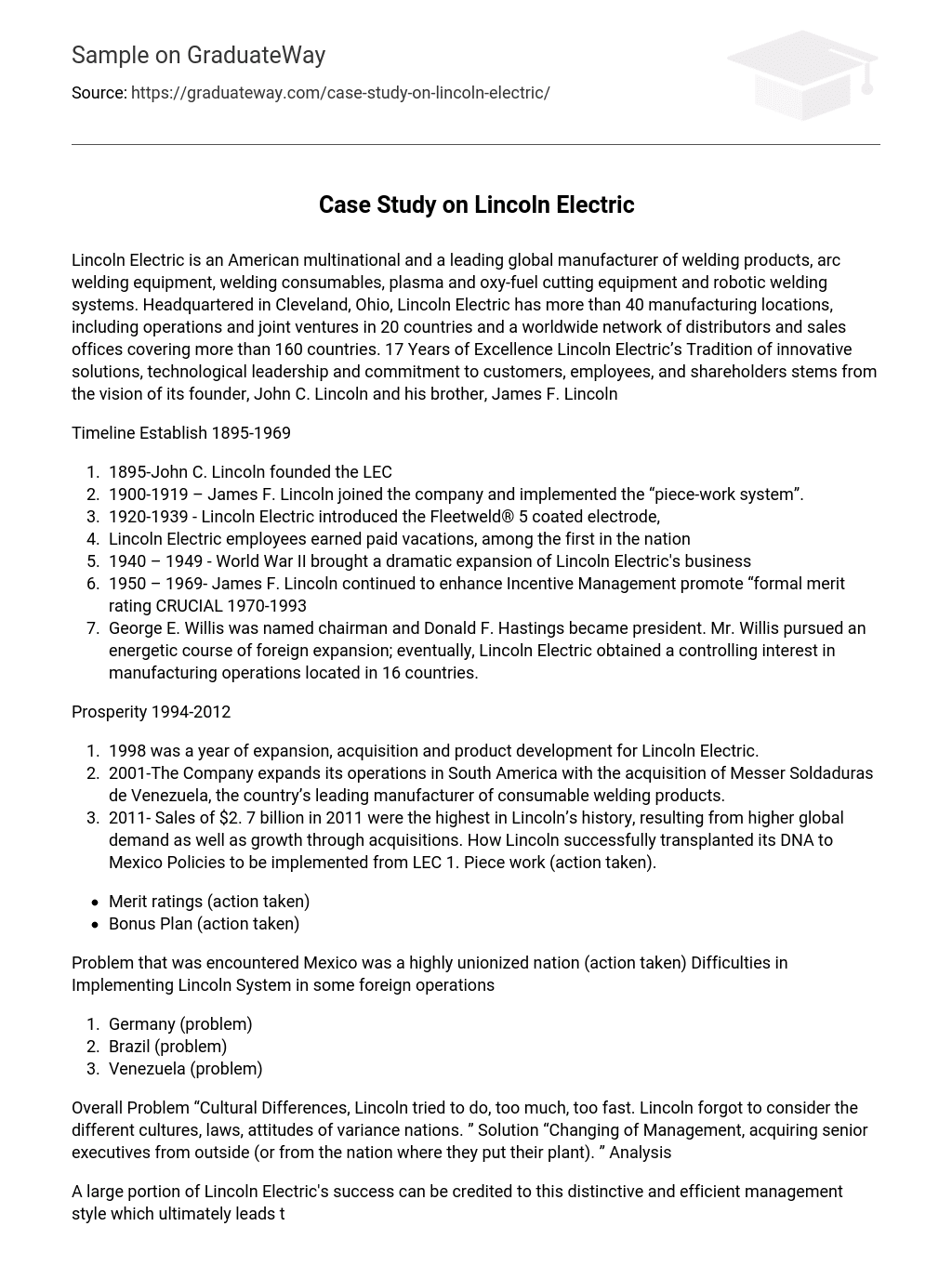Lincoln Electric, headquartered in Cleveland, Ohio, is a multinational corporation known for its production of welding products and equipment. These include arc welding equipment, welding consumables, plasma and oxy-fuel cutting equipment, and robotic welding systems. With over 40 global manufacturing locations (including operations in 20 countries) and an extensive network of distributors and sales offices across 160 countries, Lincoln Electric has established itself as a prominent player in the industry. The company’s achievements are the result of its unwavering commitment to innovation and technological leadership, as well as its dedication to customers, employees, and shareholders. This steadfast pursuit of excellence originated from the visionary ideals of founders John C. Lincoln and James F. Lincoln.
Timeline Establish 1895-1969
- 1895-John C. Lincoln founded the LEC
- 1900-1919 – James F. Lincoln joined the company and implemented the “piece-work system”.
- 1920-1939 – Lincoln Electric introduced the Fleetweld® 5 coated electrode,
- Lincoln Electric employees earned paid vacations, among the first in the nation
- 1940 – 1949 – World War II brought a dramatic expansion of Lincoln Electric’s business
- 1950 – 1969- James F. Lincoln continued to enhance Incentive Management promote “formal merit rating CRUCIAL 1970-1993
- George E. Willis was named chairman and Donald F. Hastings became president. Mr. Willis pursued an energetic course of foreign expansion; eventually, Lincoln Electric obtained a controlling interest in manufacturing operations located in 16 countries.
Prosperity 1994-2012
- 1998 was a year of expansion, acquisition and product development for Lincoln Electric.
- 2001-The Company expands its operations in South America with the acquisition of Messer Soldaduras de Venezuela, the country’s leading manufacturer of consumable welding products.
- 2011- Sales of $2. 7 billion in 2011 were the highest in Lincoln’s history, resulting from higher global demand as well as growth through acquisitions. How Lincoln successfully transplanted its DNA to Mexico Policies to be implemented from LEC 1. Piece work (action taken).
- Merit ratings (action taken)
- Bonus Plan (action taken)
Problem encountered: Mexico was a highly unionized nation
Action taken: Difficulties in implementing Lincoln System in some foreign operations
- Germany (problem)
- Brazil (problem)
- Venezuela (problem)
In general, the problem was that Lincoln tried to do too much too quickly without taking into account the cultural differences, laws, and attitudes of different nations. The solution is to change the management by hiring senior executives from outside or from the nation where the plant is located. This analysis highlights the need for considering cultural and legal differences when making business decisions.
A significant factor in Lincoln Electric’s success can be attributed to its unique and effective management style, resulting in a competitive advantage. In terms of structure, the company aims to flatten the hierarchical system and remove unnecessary middle management roles. Lincoln Electric has implemented an “open-door” policy between production workers and executives and established an Advisory Board, consisting of worker representatives, which holds bi-monthly meetings with executives. James Lincoln devised a plan to boost employee motivation.
The introduction of the Incentive Management System aims to motivate employees by offering bonuses, which are derived from a significant portion of the corporation’s annual profits. This system has two main outcomes. Firstly, it fosters a strong sense of ownership throughout the company as employees are rewarded when the company performs well as a whole. Secondly, it leads to enhanced personal performance as employees engage in a subtle competition within their respective work groups. This strategic incentive system greatly contributes to productivity, as workers are motivated to increase their efforts and output. On average, year-end bonuses amount to approximately 100% of regular compensation.
- Management built success of company on two factors:
- Producing more of a progressively better product at a lower price
Employee earnings and promotion are directly related to the success of the company. Profits were evenly distributed among workers, customers, and management, with savings passed on to customers. However, there were issues as Lincoln attempted rapid expansion, acquiring nine businesses and building two new plants in a span of five years from the late 1980s to the early 1990s.
In its haste, the company overlooked the crucial factor responsible for its success – the people. It failed in proper planning for cultural differences and how they would impact its management systems. Additionally, due to being overstretched, it couldn’t effectively transfer the systems. Moreover, despite a global recession, it paid high prices for properties in Europe. This was due to multinational companies seeking a manufacturing presence in Europe before all internal European tariffs were eliminated by the European Union, leading to a high demand for these assets.
Following Lincoln’s acquisition of these properties, the recession led to a significant decrease in their production capacity, resulting in widespread layoffs. To address this issue, Lincoln Electric should consider implementing a new management style. They should reconsider their current practice of promoting employees from within and instead focus on recruiting experienced senior executives from external sources, particularly those with international experience. In my opinion, Lincoln needs to expand its existing culture to encourage cooperation and open communication between workers and management.
This involves establishing ethical relationships with business partners, both within peer units and within society, in order to achieve the common good and pursue long-term financial sustainability. Additionally, Lincoln recognized the importance of enhancing the current training and mentoring culture to promote holistic knowledge management and facilitate personal growth for employees. However, management was complacent and believed there was no need to adjust their strategy or be concerned about the future, as employees had faith in them and a constant demand for their product. The primary obstacle lies in keeping pace with technological advancements and ensuring profitability.





